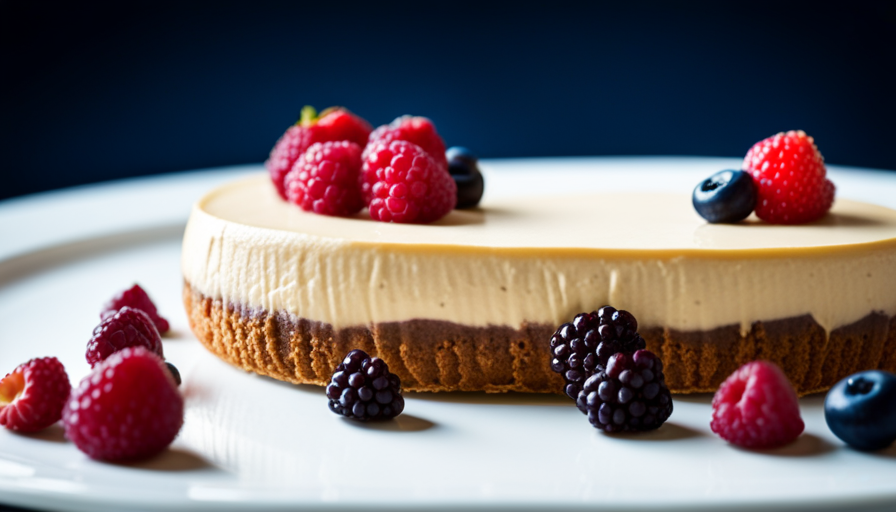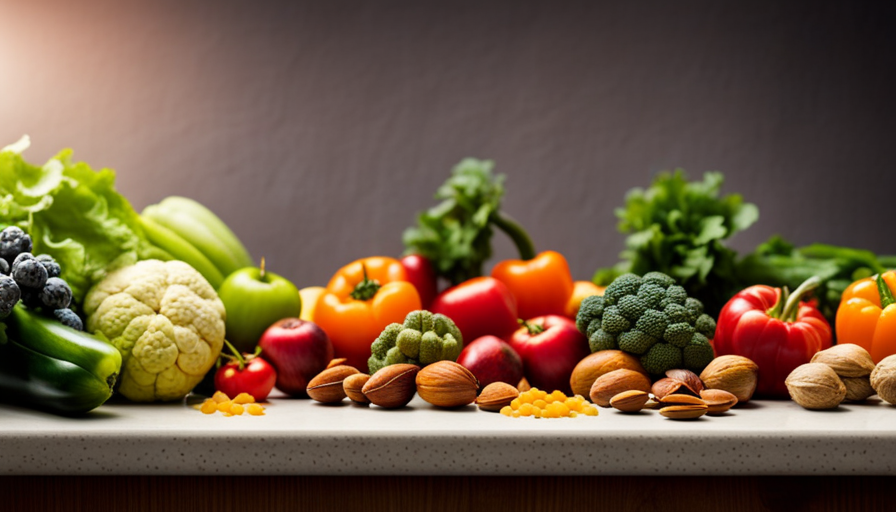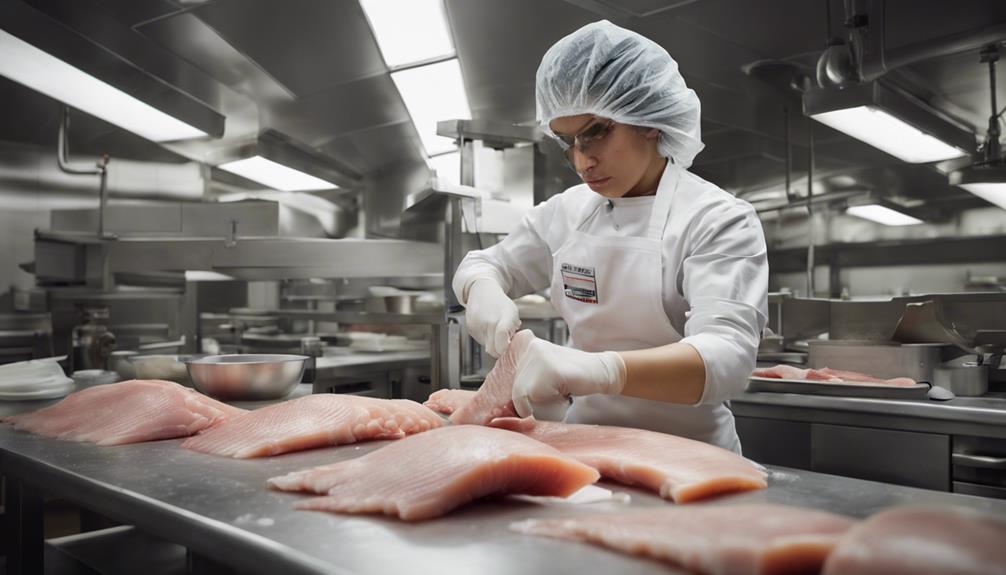Are you looking for a rich and decadent dessert that won’t make you feel guilty? Raw food cheesecake is the answer! This delicious treat puts a healthy spin on the traditional dessert, filled with wholesome ingredients that will nourish your body and satisfy your craving for something sweet.
Imagine biting into a velvety slice of cheesecake, made entirely from natural and nutrient-rich ingredients. From the crunchy nuts and seeds forming the base to the luscious coconut products and non-dairy milk creating the creamy filling, every element of raw food cheesecake is carefully chosen to provide both flavor and nutrition.
Dates and sweeteners add a touch of natural sweetness, while fresh fruits lend a burst of freshness. Natural flavorings and thickeners enhance the taste and texture, creating a truly decadent experience. And let’s not forget the optional toppings that can take your raw food cheesecake to the next level of indulgence.
Whether you’re following a raw food diet or simply looking for a guilt-free dessert option, raw food cheesecake is a delightful and nourishing treat that will leave you craving more.
So, let’s dive into the world of raw food cheesecake and explore the ingredients that make it so irresistible.
Key Takeaways
- The main ingredients in raw cheesecake include nuts, seeds, coconut products, dates, sweeteners, and fresh fruits.
- Nuts and seeds provide healthy fats, protein, fiber, vitamins, and minerals, with each variety having unique flavors and nutritional profiles.
- Dates are a natural sweetener packed with fiber, potassium, and magnesium, and can be used to make the crust for raw cheesecake.
- Coconut products like coconut oil, coconut milk, and shredded coconut are versatile and nutritious additions to raw cheesecake.
Nuts and Seeds
Get ready to indulge in a creamy and guilt-free dessert, because this raw food cheesecake is packed with a delightful blend of nuts and seeds! Nuts and seeds aren’t just delicious but also provide a plethora of nutritional benefits. They’re rich in healthy fats, protein, fiber, vitamins, and minerals.
Incorporating nuts and seeds into your diet can help improve heart health, boost brain function, and support overall well-being.
When it comes to nuts, there are various varieties available, each with its unique flavor and nutritional profile. Almonds, for instance, are loaded with vitamin E and antioxidants, which promote healthy skin and reduce oxidative stress. Walnuts, on the other hand, are packed with omega-3 fatty acids, known for their anti-inflammatory properties. Cashews offer a creamy texture and are a great source of copper, a mineral essential for energy production.
Seeds, such as chia, flax, and pumpkin seeds, are also fantastic additions to this raw food cheesecake. Chia seeds are high in fiber and omega-3s, while flax seeds are rich in lignans, which have antioxidant and estrogenic properties. Pumpkin seeds provide a good source of magnesium and zinc, essential for immune function and bone health.
Now that we’ve explored the nutritional benefits and different varieties of nuts and seeds, let’s move on to the next section about dates and sweeteners.
Dates and Sweeteners
Indulge your sweet tooth with the lusciousness of dates and a touch of natural sweetness in your homemade raw cheesecake. Dates are an excellent choice for adding a natural sweetness to your dessert. They’re packed with fiber and essential minerals like potassium and magnesium. To make the crust for your raw cheesecake, simply process dates with nuts or seeds until you achieve a sticky consistency.
In addition to dates, there are various alternative sweeteners you can use to enhance the flavor of your raw cheesecake. One popular option is honey, which not only adds sweetness but also provides potential health benefits due to its antibacterial and antioxidant properties. Maple syrup and agave nectar are other alternatives that can lend a unique flavor profile to your dessert.
To make your raw cheesecake even more exciting, consider incorporating other ingredients like coconut sugar, stevia, or monk fruit sweetener. These alternative sweeteners can help you achieve the desired level of sweetness without relying solely on traditional sugar.
Transitioning to the next section about fresh fruit, you can further enhance the flavor and presentation of your raw cheesecake by topping it with a variety of fresh fruits.
Fresh Fruit
To enhance the flavor and presentation of your homemade dessert, you can take advantage of the vibrant colors and natural sweetness of fresh fruit by topping it with a variety of juicy options, such as succulent strawberries, tangy blueberries, or tropical pineapple. Did you know that adding fresh fruit to your cheesecake not only adds a burst of flavor, but it also provides essential vitamins and antioxidants to support your overall health?
Incorporating fresh fruit into your raw food cheesecake offers numerous benefits. First, it adds a refreshing and natural sweetness that complements the creamy texture of the cheesecake. Additionally, fresh fruit provides essential nutrients like vitamin C, fiber, and potassium. These nutrients promote a healthy immune system, aid digestion, and support heart health.
Furthermore, incorporating fresh fruit allows for creative ways to present your raw food cheesecake. You can arrange the fruit slices in a decorative pattern on top of the cheesecake, creating a visually appealing dessert that will impress your guests. Alternatively, you can blend the fruit with the cheesecake mixture to create a vibrant and flavorful filling.
Next, let’s explore the delicious possibilities of using coconut products in our raw food cheesecake recipe.
Coconut Products
Coconut products are a versatile and nutritious addition to any kitchen. Coconut oil, known for its high smoke point and distinct flavor, is a popular cooking oil and a great source of healthy fats.
Coconut milk, made from the flesh of mature coconuts, is a creamy and dairy-free alternative for baking, cooking, and making smoothies.
Lastly, shredded coconut adds a delightful texture and flavor to both sweet and savory dishes, making it a must-have ingredient for any coconut lover.
Coconut oil
Smooth and creamy, the cheesecake filling is made with a generous dollop of velvety coconut oil that adds a rich and decadent flavor. Coconut oil is a key ingredient in raw food cheesecake recipes because of its unique texture and taste.
It is extracted from the meat of mature coconuts and provides a smooth consistency to the filling. Not only does coconut oil enhance the flavor, but it also adds a subtle hint of coconut that complements the other ingredients perfectly. Additionally, coconut oil is known for its health benefits, as it contains medium-chain triglycerides (MCTs) that can boost metabolism and support weight loss.
When using coconut oil in cheesecake recipes, it is important to melt it gently to preserve its nutrients and maintain its creamy texture.
Transitioning to the next section about coconut milk, this versatile ingredient will further enhance the lusciousness of our raw food cheesecake.
Coconut milk
Indulge yourself with the velvety richness of coconut milk, elevating the decadence of your cheesecake filling to new heights. Coconut milk is a creamy and dairy-free alternative that adds a subtle tropical flavor and a silky texture to your raw food cheesecake. It is made from the flesh of mature coconuts and is packed with essential nutrients like vitamins C, E, and B, as well as minerals like potassium and magnesium. It also contains healthy fats that are beneficial for your heart and digestion. When combined with nuts and seeds, coconut milk creates a smooth and creamy base for your cheesecake while adding a distinct nutty undertone.
As we move on to the next section about shredded coconut, get ready to enhance the texture and taste of your raw food cheesecake even further.
Shredded coconut
When incorporated into your recipe, shredded coconut adds a delightful touch of texture and flavor. Studies show that it can enhance the overall satisfaction of indulging in a dessert. Shredded coconut isn’t just delicious, but it’s also a nutritious addition to your raw food cheesecake. It’s packed with healthy fats, including medium-chain triglycerides (MCTs) that are easily metabolized and provide a quick source of energy. These healthy fats can help support brain health and boost metabolism.
Additionally, shredded coconut is rich in fiber, which aids in digestion and promotes a feeling of fullness. It also contains essential vitamins and minerals like iron, potassium, and magnesium. Incorporating shredded coconut into your raw food cheesecake ensures a mouthwatering treat that’s not only delicious but also nutritious.
Moving on to the next section about natural flavorings, let’s explore how they can elevate the taste of your cheesecake.
Natural Flavorings
When it comes to adding natural flavorings to recipes, there are a few key ingredients that I always reach for. First, vanilla extract adds a warm and sweet aroma to any dish, whether it’s a creamy cheesecake or a batch of chocolate chip cookies.
Next, lemon zest adds a bright and citrusy punch that enhances the flavors of both sweet and savory dishes.
Finally, cacao powder brings a rich and intense chocolate flavor to desserts like raw food cheesecake, giving it a decadent and indulgent taste.
Vanilla extract
Using a touch of vanilla extract will give your raw food cheesecake a heavenly aroma and irresistible flavor. The benefits of using vanilla extract in raw food desserts are numerous. Not only does it add a warm and sweet note to your dish, but it also enhances the overall taste profile.
Vanilla extract is a natural flavoring that can elevate the flavors of raw ingredients, providing a more complex and satisfying experience. It pairs well with fruits, nuts, and even chocolate, making it a versatile ingredient for raw food recipes. You can incorporate vanilla extract in raw food desserts by adding it to the crust, blending it into the filling, or drizzling it on top as a finishing touch.
It adds depth and richness to your raw food cheesecake, creating a truly indulgent treat. Now, let’s move on to the next delightful ingredient, lemon zest.
Lemon zest
To add a burst of bright and refreshing flavor to your creation, sprinkle a generous amount of zesty lemon onto your masterpiece.
Lemon zest, the outermost layer of the lemon peel, is packed with incredible benefits. Not only does it bring a tangy and citrusy taste, but it also adds a pop of color to your raw food cheesecake.
Here are four reasons why lemon zest is a must-have ingredient:
-
Enhances flavor: Lemon zest intensifies the overall taste of your cheesecake, giving it a vibrant and zingy profile.
-
Provides antioxidants: Loaded with vitamin C and flavonoids, lemon zest helps boost your immune system and fight off free radicals.
-
Adds texture: The tiny, fragrant lemon zest flecks create a delightful texture that complements the creamy cheesecake base.
-
Aids digestion: The natural oils in lemon zest can aid in digestion and promote a healthy gut.
If you’re looking for alternatives to lemon zest, you can try using lime zest or orange zest for a different twist.
Now, let’s move on to the next ingredient, cacao powder.
Cacao powder
Indulge yourself in the rich and velvety goodness of cacao powder, adding a touch of decadence to your masterpiece. Cacao powder, also known as raw chocolate, is a key ingredient in raw food cheesecake recipes.
Derived from the cacao bean, this powder is rich in antioxidants, iron, magnesium, and other essential nutrients. With its intense and deep flavor, cacao powder brings a delightful chocolatey taste to your cheesecake. Its smooth texture effortlessly blends with the other ingredients, creating a luscious and indulgent dessert.
Whether used in the crust or as a flavor enhancer in the filling, cacao powder adds depth and complexity to your raw food cheesecake.
Now, let’s explore the exciting world of superfood additions that will take your cheesecake to the next level.
Superfood Additions
Hey, imagine adding nutrient-packed superfoods to your raw food cheesecake recipe – it’s like giving your taste buds a healthy high-five! Superfoods are known for their exceptional health benefits, and incorporating them into your cheesecake can take it to a whole new level.
Here are two sub-lists to help you get started:
Superfood Benefits:
- Chia Seeds: These tiny powerhouses are packed with fiber, omega-3 fatty acids, and antioxidants. They can help boost digestion and promote a healthy heart.
- Goji Berries: These vibrant berries are a rich source of vitamins, minerals, and antioxidants. They can enhance your immune system and promote healthy skin.
Alternative Sweeteners:
- Medjool Dates: These naturally sweet fruits are packed with fiber, potassium, and antioxidants. They provide a delicious caramel-like flavor to your cheesecake.
- Maple Syrup: This natural sweetener contains essential minerals like zinc and manganese. It adds a rich, sweet taste to your cheesecake without the guilt.
By incorporating these superfoods and alternative sweeteners into your raw food cheesecake, you can create a dessert that not only satisfies your sweet tooth but also nourishes your body.
Now, let’s move on to the next section about non-dairy milk and explore more delicious options for your cheesecake creation.
Non-Dairy Milk
Incorporating non-dairy milk into your recipe can add a creamy and luscious texture to your homemade creation. For those looking to avoid nuts, there are several nut-free alternatives available, such as oat milk, rice milk, and coconut milk. These options provide a rich and smooth consistency that is perfect for a raw food cheesecake.
Oat milk, made from soaked and blended oats, is a popular choice due to its mild flavor and creamy texture. It’s also naturally sweet, which can enhance the overall taste of the cheesecake.
Rice milk, made by blending cooked rice with water, has a slightly thinner consistency but still provides a smooth and silky mouthfeel.
Coconut milk, extracted from the grated meat of mature coconuts, adds a tropical twist to the cheesecake with its rich and creamy texture.
In addition to their taste and texture, non-dairy milks offer various health benefits. Oat milk is a good source of fiber, while rice milk is often fortified with vitamins and minerals. Coconut milk contains medium-chain triglycerides (MCTs), which are easily digestible and may help boost metabolism.
By incorporating nut-free non-dairy milk into your raw food cheesecake recipe, you can create a delicious dessert that is both creamy and healthy.
Now, let’s move on to the next step and explore the importance of incorporating healthy fats into your cheesecake.
Healthy Fats
Boost your cheesecake with healthy fats that’ll give it a luxurious and velvety texture you won’t be able to resist. When it comes to raw food cheesecake, there are plenty of options for incorporating healthy fats, but it’s important to consider any nut allergies you or your guests may have.
While nuts are a common source of healthy fats in raw food recipes, there are alternatives available. One great option is coconut oil. Not only does it provide a creamy texture, but it also adds a subtle tropical flavor. Coconut oil contains medium-chain triglycerides, which are easily metabolized by the body and can provide a quick source of energy.
Another alternative to nuts is avocado. Avocado is rich in monounsaturated fats, which are known to be heart-healthy. It also adds a silky smoothness to the cheesecake. To incorporate avocado into your recipe, simply blend it with the other ingredients until smooth.
By using these healthy fat alternatives, you can create a raw food cheesecake that’s both delicious and suitable for those with nut allergies. Now, let’s move on to the next section and explore the role of natural thickeners in creating the perfect texture for your cheesecake.
Natural Thickeners
To achieve the perfect velvety texture for your delectable creation, you’ll want to explore the realm of natural thickeners, which will transform your cheesecake into a smooth and indulgent delight. Natural thickeners are key ingredients that not only add body to your raw food cheesecake but also contribute to its creamy consistency. They help bind the ingredients together, creating a cohesive and satisfying dessert.
There are several natural thickeners that work wonderfully in raw food cheesecakes. One popular option is agar agar, a seaweed-derived ingredient that sets beautifully at room temperature. Another option is psyllium husk, which absorbs liquid and forms a gel-like substance that helps thicken the cheesecake filling. Lastly, cashews, when soaked and blended, create a thick and creamy consistency that is perfect for cheesecakes.
Incorporating these thickeners into your raw food cheesecake recipe will elevate the overall texture and mouthfeel of your dessert. They will provide a smooth, luxurious experience that will impress your taste buds and leave you wanting more.
Next, let’s move on to optional toppings that will add an extra layer of flavor and visual appeal to your raw food cheesecake creation.
Optional Toppings
When it comes to topping off a delicious raw food cheesecake, there are a few optional ingredients that can take it to the next level.
Fresh fruit slices are a fantastic choice, adding a burst of natural sweetness and vibrant colors to the dessert.
Shredded coconut offers a delightful texture and a hint of tropical flavor, while cacao nibs provide a rich and slightly bitter taste that complements the creamy cheesecake beautifully.
Together, these toppings create a harmonious combination of flavors and textures that will leave your taste buds wanting more.
Fresh fruit slices
Savor the delightful burst of flavor as you bite into a slice of this raw food cheesecake adorned with juicy, fresh fruit slices. The combination of creamy cheesecake and vibrant fruits creates a tantalizing treat that’s both visually appealing and delicious.
You can choose from a variety of fruits to create your own fruit salad topping, such as succulent strawberries, tangy blueberries, and sweet mango slices. These fruits not only add a pop of color to the cheesecake but also provide a refreshing contrast to the rich and creamy texture of the cake.
Additionally, you can use leftover fruit to make fruit smoothies, perfect for pairing with a slice of cheesecake.
As you move on to the next section about ‘shredded coconut,’ you’ll discover another delightful addition to this raw food cheesecake.
Shredded coconut
Indulge in the tropical delight of shredded coconut, sprinkled generously on top of your slice of creamy heaven, like a gentle dusting of snow on a mountaintop.
Shredded coconut adds a wonderful texture and flavor to raw food cheesecake recipes. Its natural sweetness enhances the overall taste while providing a satisfying crunch.
Coconut is a versatile ingredient that can be used in various coconut dessert recipes, such as coconut macaroons and coconut cream pie. When incorporated into raw food cheesecake, it brings a tropical twist to the classic dessert.
The nutty flavor of the shredded coconut perfectly complements the smooth and creamy filling, creating a harmonious balance of flavors.
As we move on to the next section about ‘cacao nibs’, get ready to explore another delicious addition to your raw food cheesecake creation.
Cacao nibs
Now let’s talk about cacao nibs, a delicious and nutritious ingredient for raw food cheesecake. Cacao nibs are small pieces of crushed cacao beans that offer a rich and intense chocolate flavor. They’re packed with health benefits, making them a great addition to any raw dessert.
Firstly, cacao nibs are an excellent source of antioxidants, which help fight against free radicals and reduce the risk of chronic diseases. They’re also a good source of fiber, magnesium, and iron, promoting a healthy digestive system and supporting overall well-being.
When it comes to incorporating cacao nibs into raw food desserts, the possibilities are endless. You can sprinkle them on top of your cheesecake for a crunchy texture or mix them into the crust for a chocolatey twist. Another creative idea is to blend them into the filling for an extra burst of chocolate flavor.
Cacao nibs not only enhance the taste of raw food cheesecake but also provide numerous health benefits. So go ahead and experiment with these delightful nibs to create a truly decadent and nutritious dessert.
Frequently Asked Questions
Can I use any type of nuts and seeds for the raw food cheesecake recipe?
Yes, you can substitute cashews for almonds in the raw food cheesecake recipe. Cashews have a creamy texture that works well as a base for the cheesecake filling.
Additionally, you can use other types of nuts such as walnuts, pecans, or macadamia nuts to add different flavors and textures.
If you prefer a nut-free version, you can try using sunflower seeds or pumpkin seeds as a substitute for the nuts.
Are there any alternatives to using dates as a sweetener in the raw food cheesecake recipe?
When it comes to sweetening a raw food cheesecake, there are a few alternatives to using dates. One option is to use other natural sweeteners like maple syrup or agave nectar. These can provide a similar level of sweetness without the date flavor.
Another tip for reducing the sweetness is to use less sweetener overall or balance it out with tart ingredients like lemon juice. Experimenting with different combinations can help you find the perfect level of sweetness for your raw food cheesecake.
Can I use any type of fresh fruit for the raw food cheesecake recipe?
Yes, you can definitely use a variety of fresh fruits as an alternative sweetener in the raw food cheesecake recipe. Some popular options include mashed bananas, pureed mangoes, or blended berries. These fruits not only add natural sweetness but also contribute to the creamy texture of the cheesecake.
Additionally, you can get creative with fruit combinations like strawberry and kiwi or pineapple and coconut for a unique and flavorful twist.
What are some examples of coconut products that can be used in the raw food cheesecake recipe?
Coconut milk and coconut oil are two fantastic ingredients that can be used in the raw food cheesecake recipe. These coconut products add a rich and creamy texture to the cheesecake, making it even more delicious.
Coconut milk provides a subtle tropical flavor, while coconut oil adds a smoothness to the filling. Incorporating these coconut products into the recipe will definitely elevate the taste and make your raw cheesecake absolutely irresistible.
Are there any natural flavorings that can be used as alternatives in the raw food cheesecake recipe?
There are several natural sweeteners and flavorings that can be used as alternatives in a raw food cheesecake recipe. Some of the best natural sweeteners include maple syrup, agave nectar, and dates.
As for flavorings, options like vanilla extract, almond extract, and lemon zest can add a delicious taste to the cheesecake. These natural ingredients not only enhance the flavor but also provide a healthier option compared to artificial additives.
Can Raw Food Cheesecake Be Included in a Raw Food Diet?
Yes, raw food cheesecake can be included in a raw food diet. By using ingredients like nuts, seeds, and fruits, you can enjoy a decadent dessert while still reaping the raw food benefits and tips for a healthy lifestyle. This delicious treat is a satisfying way to indulge while staying true to your diet.
Conclusion
In conclusion, creating a raw food cheesecake is a delightful adventure for your taste buds. By combining a variety of nuts and seeds, along with dates and sweeteners, you can achieve a creamy and delicious base.
Adding fresh fruit, coconut products, and natural flavorings will elevate the taste to another level. Non-dairy milk provides a smooth consistency, while healthy fats and natural thickeners enhance the texture.
And just like the cherry on top of a sundae, optional toppings can add that extra touch of indulgence. So why not dive into this raw food cheesecake experience and savor each bite like a summer breeze caressing your senses?

















